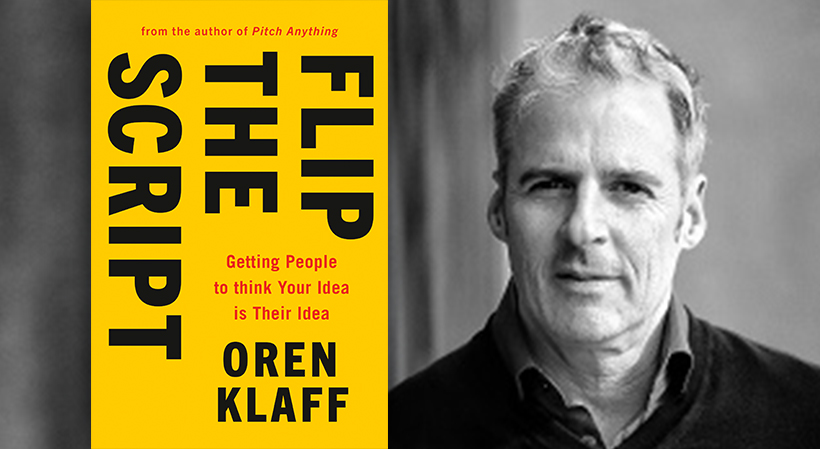The following is excerpted from “Flip the Script: Getting People to Think Your Idea Is Their Idea” by Oren Klaff, in agreement with Portfolio, an imprint of Penguin Publishing Group, a division of Penguin Random House LLC. Copyright © Oren Klaff, 2019.
Imagine you just created a new cold medicine, and you find it’s 35 percent more effective than other popular cold meds on the market. Users administer it by vaping rather than taking a pill, so it doesn’t have to be swallowed. And it’s completely safe to use. Great!
You’re obviously excited and your mind is going a mile a minute thinking about how popular this new product will be (and how much money you’re going to make). Some wealthy friends think it sounds like a slam dunk, so they give you a cash investment and you spend two years working out the details, and when you finally put it on store shelves… nobody buys it.
Cold medicine that requires a vaporizer? No, thanks. It’s just too novel.
For the most part, customers and consumers rely on their tried-and-true suppliers or on their network of friends to suggest new products, rather than trying every new solution that hits the market. Certainly there is a small set of adopters who will try unproven products and take the risk on new ideas and technologies—but this is not true of the mainstream, middle-of-the-road consumer.
In practice, too much novelty produces avoidance and not the hoped-for attraction effect.
The grocery store shelves are already lined with a dozen different kinds of cold medication. Your customers have all been seeing the common brands on the shelf for years and years. They already have a medication they use, which their doctor recommended and all their friends use, too. These people aren’t out looking for a new cold medication that might be one-third better. And they definitely don’t want to switch from taking pills to vaping, because they’ve never heard of anyone taking cold medicine like that before; it’s too unfamiliar.
Related: Thought Leader Pat Flynn Shares the Keys to Attracting Superfans
To influence people to try a new kind of anything, you first need to find somebody who is willing to listen to you talk about your new thing, whatever it is. At this stage, positioning a project or idea as completely new and original can cause a deceptive amount of interest. These people will listen to the idea. And yes, they’ll be intrigued, maybe even engaged and excited. But when it comes to making a decision, they’re likely to return to the products and ideas that are already in place and known to work—even if those products and ideas are just average.
This counterintuitive consumer behavior has frustrated thousands of entrepreneurs, who often get fired after telling their board of directors, “It’s a great product, so much better than anything else on the market… but we are just not selling, and are not going to hit our revenue goals this year.”
For more than a decade, my colleagues and I have watched countless companies attempt to sell their products, services and ideas to all types of buyers.
Through interviews, working sessions and consulting directly with hundreds of executives, I’ve seen the way most sales presentations go:
- Salesperson creates excitement by pointing out new features, ideas or technology
- Introduces the offering as new and “totally different” from the competition
- Explains that “this is a new kind of company—we do things differently”
- Points to industry innovation awards
- Typically quotes Steve Jobs’s commercials or keynote speech: “Here’s to the crazy ones… the rebels. The troublemakers. The round pegs in the square holes. The ones who see things differently.”
- Moves to the next cliché, comparing their company to disruptive tech giants, Google, Airbnb, Etsy, or Uber (“We’re the Uber of toothpaste, really.”)
- Tries to overcome objections and ask for the sale
This rarely works.
So why would sellers consistently choose this particular way to highlight their products?
In other words, why are people seemingly preprogrammed to present their ideas as new and different? Because new and different things attract immediate attention.
If it sounds new, we can be sure to get a solid look, a return phone call, or an in-person meeting based on novelty. When people hear new ideas, they initially get excited, which provides social validation and gives the seller the illusion of an elevated interest level. But this rise is temporary, and when the exhilaration of new and different wears off, the desire for tried-and-true takes over, and it is surprisingly difficult to get people to actually change their behavior.
One example of this today is with self-driving cars.
For the first time in history, we are seeing the commercial release of the fully autonomous drive-you-anywhere-you-want-to-go car. General Motors makes one, and Ford and Tesla do, too. So do Toyota, Nissan, Porsche and Mercedes, and even Kia will have one soon. Let’s assume the cars work like any other, except the one I’m suggesting you buy has no steering wheel you can turn, no brakes you can push, no turn signals or any other controls. The only thing you can touch is the radio knob. So now let me ask— when are you going to buy one?
Your answer to this question will tell me what risks you’re willing to take in life. If your reply is, “Did you say no steering wheel or brakes? No way, I’m not buying that until hell freezes over,” then you are probably a late adopter, an average consumer who buys around the same time everyone else does. You got an iPhone when the hundredth person in a week pulled one out to show you what they had for breakfast.
Maybe your answer is “I have to have the very first self-driving car available.” There aren’t a lot of you guys out there, because you people are the crazy ones Jobs was talking about. The crazy ones who pursue new technology products aggressively and buy the moment they hear “We have two available—want one?”
But this early versus late adopter market segmentation concept falls apart when the stakes go up. Time and time again my team has found that the bigger and more important a decision is, the more likely it is to be made based on conservative criteria. When lives are at stake, jobs are on the line, and the company has to meet its goals to pay the bills, new and exciting ideas will almost always be considered but passed up. Ask someone who is into driverless cars what they think about fully automated surgeon-less heart surgery. Oh, they’ll be interested to hear about it, and they’ll approach, but when it’s time to commit, the avoidance behavior is going to win out.
This leaves us with a problem. The best method to get people to listen and pay attention to our ideas is to make what we are saying seem new and exciting. But doing so can trigger anxiety and avoidance, and they won’t be likely to take action when it counts later on. On the other end of the spectrum, if we make our message seem normal and nonthreatening from the beginning, it’s possible nobody will listen to it.
Sign Up: Receive the StartupNation newsletter!
Where’s the balance?
The trick is to use a technique called Novelty Chunking to make it seem like your deal is different from “normal” in just one key way, while everything else about the deal is completely Plain Vanilla.
Then, you show the buyer that what’s normal is shifting, and the one key, different thing is really popular today.
There is a new normal.
“Flip the Script: Getting People to Think Your Idea Is Their Idea” is available now wherever books are sold and can be purchased via StartupNation.com.






